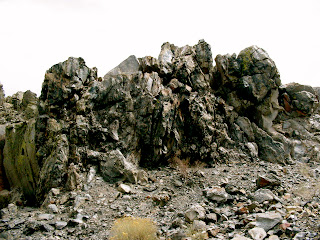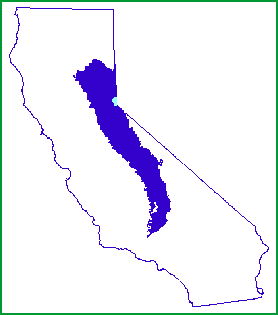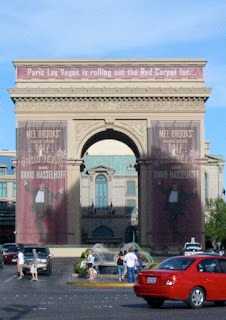If I learned one lesson from this trip, it is this:
ON ANY FUTURE CAR TRIP, CARRY A SPARE KEY!
We had already had one lost-key situation in
Kayenta, Arizona.
I didn't consider that one to be my fault, so I didn't take the lesson to heart.
Fool!I had
never lost a car key in my entire life. No matter: I had been warned.
Now it was time to pay the price.
Here is how the situation unfolded...
 Panum Crater: my date with disaster
Panum Crater: my date with disaster
N37.93149 W119.04663(12:30): I decide to visit the
Panum Crater near
Mono Lake. Only 650 years old, this is the youngest mountain in the youngest mountain range in America, the Mono Craters. Volcanic eruptions began here about 40,000 years ago, and geologists believe they are by no means finished. These are mountains in the very earliest stage of formation.
When Panum erupted (c. 1325-1365 AD), it spewed forth lava with a very high concentration of silica (about 76% quartz), making it very thick and glassy. This lava cooled into several different rock forms: the abrasive stone
pumice, and its very-different-looking but chemically identical twin,
obsidian.
Obsidian is what attracted me to this place. This is a beautiful black, glassy rock that I have seen in large quantities in only one other place on my--remember, it's
"piecemeal"--Global Safari, at
Hell's Gate National Park in Kenya.
(12:52): I follow the dirt trail as far as it will take me, and park the car near the bottom of Panum's rim. From there a gently-sloping trail, about six feet wide, leads upward. The trail is "paved" with small pieces of pumice, so it feels like I'm walking on someone's giant landscaping project.
(12:59): I reach the rim, and turn left onto a trail that leads to the center of the crater, what's called the "plug". The rim formed about 1,200 years ago from pumice debris falling back to earth, and the plug (or "dome") dates from the most recent eruption. "NO ROCK COLLECTING," reads a sign along the trail:
 On the rim of the crater
On the rim of the crater Looking from the rim to the dome of the crater, about 500 feet away
Looking from the rim to the dome of the crater, about 500 feet away (1:07)
(1:07): Obsidian becomes more abundant the closer I get to the center plug. At first I see it just in small pieces along the trail, then larger rocks, and finally...
huge outcrops, taller than a man. The rock is dark, glossy, smooth, sharp and beautiful. No wonder Native Americans used this material for spear points and arrowheads. It is apparently preferred by some surgeons for scalpels even today.
(1:16): Strolling along the path, I see one outcrop after another. Up ahead, off the trail, I notice a couple with a dog that seem to be, yes I think so...collecting rocks. I begin to reason with myself. "Surely," I conclude, "a small sliver or two doesn't harm anything."
 (1:20)
(1:20): Having seen what I came to see, I turn and retrace my steps along the pumice path. It is about a third of a mile back to the car. As I come within sight of it, I reach into my pocket...and... (you know what's coming, don't you?)
THE KEY IS MISSING!!
I don't worry at first, because I never seem to place it in the same pocket anyway. So I go through them all. Nothing! Then I empty each pocket in turn, placing the contents on the hood of the RAV4. Still nothing.
(1:25): I finally have to face the awful truth: the car key is somewhere between me and the center of the crater, more than a quarter of a mile away. My water and food are
inside the vehicle. I'm miles from any town. Even if I do find it, it will take hours and I'll be very hungry and thirsty. The trail is uneven and dark: the same color as the plastic end of the key itself. But there is nothing I can do except retrace my steps, keeping my eyes on the ground.
"Oh, why? why?" My mind reels in despair. "Why did I ever think I could pick up those rocks? I'm being punished by God!"
(1:27): I start to return up the path, my eyes scanning the ground at every step. The place it is most likely to be, I decide, is near the plug, because that is where the terrain was rougher, where I had stepped off the trail to inspect some rock. As I hurry up towards the rim I pass a young couple that is just arriving here. "I've lost my car key, so if you see one please yell out," I say to them in desperation.
(1:30): I get to the crater rim, less than half the distance I have to cover. I've seen nothing at all yet. I pick up my pace somewhat, in a hurry to get back to the vicinity of the plug. I'm several hundred feet ahead of that couple I passed a few minutes ago, when I hear something... a shout, coming from their direction. It is just a single word...but the most beautiful word I could ever hope to hear:
"
TOYOTA?"
By this magnificent stroke of sheer luck, disaster was averted. The husband had seen the key sticking partly out of the pumice rocks on the trail; I had already passed it without seeing a thing.
As close calls go, this one ranks right up there with the time I was locked underground inside the
Serapeum of Saqqara. But that's another story...
 Am I glad to be leaving here!
Am I glad to be leaving here!Note to readers: With this post, there will be a pause until late next week as I travel back to New York. But please check back then, because there is still more to come! I hope you have a great Memorial Day holiday.
Next: "Goodbye, God. I'm going to Bodie."
























































